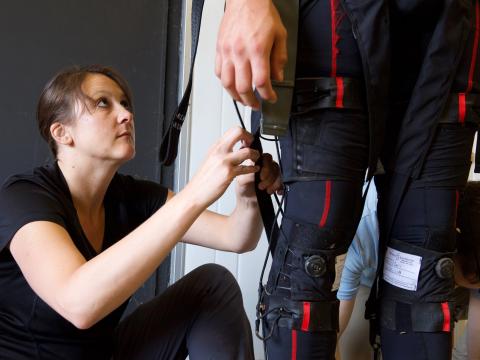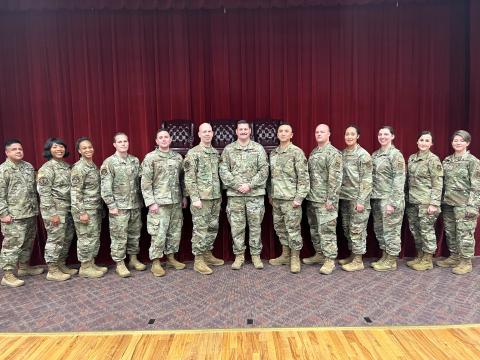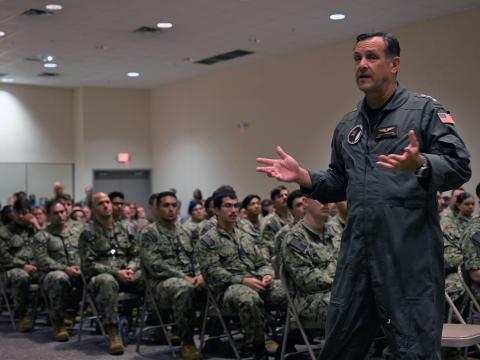Remotely Operated Communications To Link British Forces in Balkans
Using off-the-shelf technology, new system will free signalers for other deployments by end of summer.
British forces in Bosnia and Herzegovina and Kosovo will receive a new, highly automated communications network designed to reduce staffing requirements. Part of an ambitious 28-week program by the United Kingdom’s Ministry of Defence, it will replace a manpower-intensive system currently in use, allowing roughly 260 Royal Signal Corps personnel to be reassigned. Made entirely from commercial technologies, all elements must be in place and operational by late August before the harsh Balkan winter begins.
As peacekeeping enters another year in the remnants of the former Yugoslav state, experts note that North Atlantic Treaty Organization (NATO) and Partnership for Peace forces will most likely remain in theater for some time. When those units first arrived, their communications equipment usually consisted of mobile systems designed for fluid battlefield maneuvering. However, the operation soon became static, especially in areas such as Bosnia and Herzegovina where the security situation has stabilized. Based on older technologies and designed for a large-scale Cold War-era conflict, mobile systems, such as the United Kingdom’s Ptarmigan, require a considerable number of personnel to maintain and operate a communications grid. These various nodes consist of numerous manned outposts scattered on bleak hilltops throughout the region.
Faced with the need to reallocate highly skilled Royal Signal Corps personnel to other areas while at the same time maintain connectivity throughout the region, the Ministry of Defence issued a series of urgent operational requirements to design, procure and implement an automated communications network. BAe Systems, Christchurch, England, is the prime contractor and systems integrator for the program. BAe is organizing the technology from available commercial materials, testing it, deploying it and having it fully operational by the end of summer. The goal is to have two separate communications backbones in Kosovo and in Bosnia and Herzegovina. Due to terrain differences of the regions, the Kosovo network will rely on a microwave trunk while the network in Bosnia and Herzegovina will be satellite-based. However, both grids will share the same equipment and configurations where possible.
When complete, the entire system will consist of approximately 60 nodes positioned across the Balkans. Fully compatible with NATO systems, the new network will provide modern voice, data and facsimile links to the U.K.-led multinational divisions in Bosnia and Herzegovina composed of British, Canadian, Dutch and Czech units and British forces in Kosovo. It also will connect back to England.
The semistatic network is designed to last at least three years, though the contract can be extended up to seven years. According to the program’s capability leader, Lt. Col. Richard Thurston, British Army, Royal Signal Corps, the time frame will depend on several variables: the political situation—the long-term view—and the type of infrastructure needed to ensure peace and stability.
The network will replace the existing Ptarmigan-based communications system—a mobile battlefield communications network based on technology that is at least 25 years old and very manpower intensive, BAe Systems Project Manager Paul Robinson observes. Now that the situation has settled somewhat in Bosnia and Herzegovina and parts of Kosovo, he believes a more capable stationary system is needed.
Designed for transportability, each part of the new network resides in an International Standardization Organization (ISO)-style steel container measuring 8 feet high, 8 feet wide and 20 feet long. There are two separate chambers within the package: a transmission area and a switching area. Accessed by separate doors, each section is sealed for electromagnetic compatibility—effectively forming two subsystems within one shelter. According to Robinson, depending on the system configuration, one section will contain either satellite communications equipment furnished by the British government or microwave communications gear.
The second half of the container houses switching elements. These include multiplexers, private automatic branch exchangers, and cryptographic equipment. Systems management is based on BAe Systems’ generic communications and information services management system. Each shelter has a main distribution frame, which is an interface point where the troops in the theater will connect all of their barracks’ local area network and telephone lines. Each container is supported by a large uninterruptable power supply, providing a degree of protection from power outages. Both sections are air-conditioned.
When the bare containers are delivered to BAe Systems, they feature equipment racks, internal fire suppression and security equipment. BAe then fits them with communications gear, various interfaces, and a system that allows the unit to be monitored and operated remotely from a network control center.
While the containers are at Christchurch, the internal architecture of each unit is thoroughly tested. “Once we’re happy that it works as a stand-alone node, then it will be shipped. We have already completed site surveys in both theaters,” Robinson says. He adds that the British Army is now in the process of arranging for foundations, power and earthworks, and running cable from existing barracks and operational areas to the new sites.
Each unit can be configured for one or a variety of tasks. “There’s a U.K. element, a NATO element, and if you like, a black element where connectivity to the public telephone network in the Balkans is concerned,” Robinson says. Cryptographic protection for telephone-based communications is important because the main lines still go through Belgrade, he notes. To work around this awkward security situation, BAe had to devise an architecture that will allow secure access for U.K. and NATO traffic and a separate element to provide general unsecured telephone traffic.
Once the units are ready for shipment, they will be deployed in groups of 10 to their operational areas, with the Bosnia and Herzegovina network being set up first. According to Robinson, the containers are to be driven by truck to the border. Two shelters can fit on a cargo truck, with each delivery group made up of four to five vehicles. At the border, they will receive a military escort and travel to a central shipping point before deployment to specified locations. On site, they will be installed, interconnected and commissioned by teams of civilian BAe Systems employees and Royal Signals Corps personnel. If there are heavy rains in the spring and the roads prove impassable in some areas, the containers can be airlifted into position by cargo helicopter.
Once the network is in place and operational, it will allow the British Army to free nearly a regiment—some 260 Royal Signal Corps personnel—for reassignment, Col. Thurston says. The highly automated network will require about 30 technicians working in shifts to operate it throughout the Balkans. Manpower requirements will be somewhat higher in Bosnia and Herzegovina, but Dutch forces will share the responsibility for operating and maintaining the network. The colonel notes that with the automated systems, the majority of the system support can come from the primary British base in the region or even the United Kingdom. Network managers will be able to remotely bring up individual container alarms and check and monitor the progress of heat, light, power, fire systems and intruder alarms. At a simple level, the system will also allow management and configuration information to be fed back to individual containers—all controllable from one central location in the theater.
The remote management aspects of the network significantly limit the need for on-site civilian technical support. “As long as we have the repair and resupply chains and the redundancy built into the system, we do not foresee that we need a considerable amount of contractor support out there,” Col. Thurston points out.
The new system also has considerable room for growth. The colonel notes that with modern switching technology, increased capacity can be achieved by installing additional cards and leasing more bandwidth on commercial satellites that the British government is using. There are two satellite lease contracts, one with Cable and Wireless and one with British Telephone, he says.
Perhaps the greatest challenge facing the ministry and BAe Systems will be meeting the deadline before the onset of the harsh Balkan winter, Robinson says. “We’ve got to get people off hillsides and remote locations prior to the snow setting in. Time is of the essence for us. It is an overall program of 28 weeks from start to finish. Given this [deadline] means making something like 60 containers, sourcing all the product that goes inside it, providing interfaces to U.K. crypto[graphic] devices where necessary, providing a microwave backbone in Kosovo, interfacing into a SATCOM [satellite communications] network, and providing a U.K. capability hub in Whitehall—28 weeks is challenging,” he explains.
Even by using commercial materials, the project is daunting. One difficulty encountered was that, in an era of just-in-time manufacturing, very few manufacturers actually keep stock on hand. This can pose supply problems because even commercial products take time to be built. However, Robinson credits the close working relationship between BAe Systems, its suppliers and the Defence Procurement Agency for avoiding any snags.
Robinson does not believe BAe Systems’ tactical communications division has ever handled a project of this magnitude before. “I think this is probably the first time we have seen this size volume in this short a time scale and produced in this way—real COTS [commercial off-the-shelf] products pulled into a military arena and wrapped around the parameters of military operational need,” he says.
Once the containers are ready, the challenge will be the weather and the geography. Col. Thurston notes that Kosovo will be the easier of the two areas in which to deploy. He describes Kosovo as a bowl with peaks and troughs. The difficulty here will be setting up sites on the hilltops, which are usually bare stone, making it difficult to lay concrete bases to support communications equipment. Many areas in the region are also prone to high winds that can blow microwave masts down. Another potential weather-related difficulty is resupply in the winter. The generators require fuel, and refilling large fuel containers in high places is difficult in the winter, Col. Thurston emphasizes.
The larger problem will be Bosnia and Herzegovina, which the colonel describes as a communications nightmare. The region is composed of heavily wooded valleys and ridges. While there are some high points on which to set up communications equipment for static networks, connectivity for mobile units is difficult. In some areas, major roads pass through valleys with such large rock overhangs that it is like being in a tunnel for communications purposes, he says. These terrain features pose challenges for any mobile system, including satellite telephones.
While the geography dictates the type of trunk each region will have—microwave for the relatively unobstructed bowl of Kosovo and satellite for the broken terrain of Bosnia and Herzegovina—wherever they are, troops on the ground will also need more portable mobile communications.
British troops in Kosovo will use vehicle-mounted radios based on the Tetrapol system. Col. Thurston notes that the exact type of portable system for Bosnia and Herzegovina has not been selected yet, though Tetrapol and several types of satellite telephones are under consideration. The need for mobile communications is especially urgent in the Balkans to ensure that soldiers moving through the region can call for help in the event of a traffic accident or if they accidentally enter a minefield, the colonel stresses.
Mobile communications are also important for handling any contingencies or incidents in the Balkan theater. Which vehicle-based portable system is selected will be important to the mobile headquarters in the region. “We need to provide access to respond to any particular incident. So we are looking at having a mobile switch system operating through a mobile satellite communications terminal, linked back through a hub into the static network so that it gives the commander—if he has to respond to any incident on the ground—a capacity to go mobile with 16 voice channels and data channels,” Col. Thurston observes.
Security considerations still exist in both countries, the colonel notes. While Bosnia and Herzegovina has stabilized to some extent, there are factions in both countries that are continually active, which means that the British Army has to be careful where it sites its equipment. “Even if they are not active in what one can loosely describe as terrorist-type activities, there are people out there who will plunder and sell anything on the black market. We do have to ensure that the security of the installations and sites is maintained. That’s tricky in one or two places,” he says.



